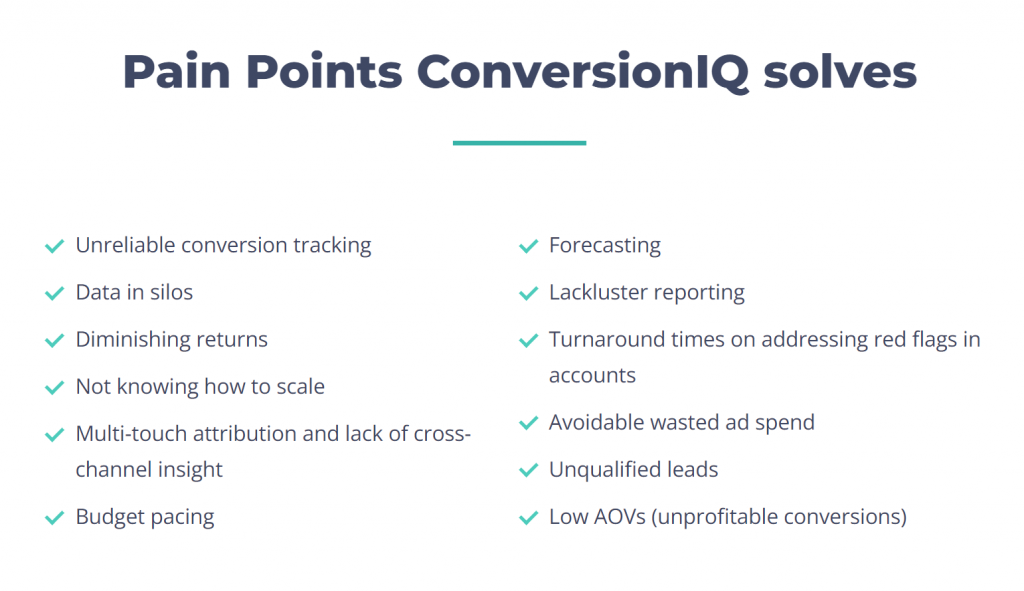How much does a Google Ads campaign cost, anyway? Let’s break down how much you should allocate to your budget.
Here you’ll find:
- How to use Google Ads for marketing your products and services
- Cost considerations
- How to analyze if Google Ads are a worthy investment
- The role of a digital marketing agency in enhancing your ad strategy
How much does a Google Ads campaign cost? Well, the answer is more complicated than you might think.
Google reports that Google Ads (formerly Google AdWords) deliver an average 200% return on investment (ROI).
The bad news? This cost doesn’t factor in other critical cost considerations, such as:
- Cost to manage Google Ads
- Tools and software prices
- Creation of assets
In other words, Google’s blanket ROI only factors in ad spend for its pay-per-click (PPC) platform. And when you consider everything that goes into a PPC campaign, what’s the true ROI?
If you’re wondering how much it costs to run a Google Ads campaign, this article will dig into every expense to help you understand if this advertising platform is the most economically viable decision to advertise your products/services.

Google reports that Google Ads (formerly Google AdWords) deliver an average 200% return on investment (ROI).
Why use Google Ads for marketing products and services?
You may not get a 200% dollar-for-dollar ROI on Google Ads, but there are several other benefits of running a Google Ads campaign, including:
1. Improved visibility
The aim of any digital marketing campaign is to get in front of potential customers. Due to Google’s massive reach, you reap the benefit of advertising to a large audience. Plus, since your ad copy usually ranks before organic results, they’re the first thing your prospects see — and click. This is a huge advantage and an excellent way to win new customers.
2. You only target interested customers
With PPC ads, you only target qualified users who have the intention to buy. You also only pay if they interact with your ads.

You may not get a 200% dollar-for-dollar ROI on Google Ads, but there are several other benefits of running a Google Ads campaign. (Image: Unsplash)
3. It’s extremely flexible
You decide your ad spend, how long you want to run your ads, who you want to target, what type of ad you want (e.g., video, shopping, display, search, local, or discovery), and what type of pricing model you want (e.g., PPC, CPM, CPV, or CPA).
4. The results come in quickly
Compared to traditional channels like SEO, which take a couple of months to show results, Google Ads work instantly. Sure, you’ll see better results if you work on both strategies together, but regardless if you have an SEO strategy or not, Google Ads will still make your product or service visible in front of your prospects at the right moment.
5. You get actionable insights
Advertisers can see how their target audience interacts with their ads and get analytics on which specific keywords get the most interest, what ad copy gets the most impressions and interactions, and learn more about the target demographic that clicks on their ads.
How much do Google Ads cost?
Now that we’ve talked about some of the additional benefits, let’s dive in deeper into Google Ads campaign cost considerations. To make it simple, we can divide Google Ads pricing into four categories:
- Ad spend
- Costs to manage it
- Creation of assets
- Tools and software needed
Ad spend
On average, businesses spend $9,000-$10,000 on Google Ads. According to Amalia Fowler, a search marketing strategist, “For small businesses who operate in a local service area with minimal competition, $1000 a month could be enough (for ad spend, before service fees).”

To truly understand how much an individual business may spend on Google Ads, you’ll need to take several factors into consideration. (Image: Adobe)
“For bigger businesses, it’s hard to say without knowing the information listed above. I have large clients who do well with $5000 and large clients who are only competitive at the $40,000 a month mark due to competition and [average cost per click (CPC),]” says Fowler.
“The best way to find out is to do keyword research, structure your campaigns, and figure out how much 100-200 clicks for those campaigns would cost you on average per month. That’s a lower volume minimum.”
However, to truly understand how much an individual business may spend on Google Ads, you’ll need to take several factors into consideration, including:
1. Your industry
The industry you belong to is a huge consideration in the pricing of your ads because different industries have different CPC costs.
For example, if you opt for ads on the Google Search Network, then you might pay $3.33 per click if you’re in the B2B space, $1.16 per click if you’re in the e-commerce space, and $6.75 if you belong to the legal industry.
If you choose to leverage ads on the Google Display Network, your CPC might be lower, even within the same industry.
2. Specific keywords you target
For any kind of search engine ads you run, you’re targeting either one of the four search intents:
- Informational
- Navigational
- Commercial investigation
- Transactional
The first two search intents might not result in any conversions. However, the last two search intents will mostly result in an action, as these users are looking to investigate a product or service or complete a purchase.
Due to search intentions being different, the audience that sees certain ads will also differ. So, you might need to target these prospects with different keywords.

(Image: Adobe)
Even if you belong to the same industry, the type of keyword and intent you bid on will directly impact the price you pay — e.g., if you’re in the legal industry, the keyword “truck accident lawyer Dallas” will have a CPC of $425, but “offshore accident lawyer” will have a CPC of $815.
In a similar way, if you belong to the real estate space, then the keyword “sell house fast Austin” will have a CPC of $95, but “worst month to sell a house” will have a CPC of $60.
3. Your Quality Score
Your ad’s Quality Score has a direct correlation to your CPC (and your ad rank!). The better your Quality Score, the lower your CPC and the better your ad placement.
It’s recommended that your Quality Score be at least 5. If it’s lower than 5, your CPC increases, but if it’s higher than 5, your CPC decreases.
For example, with a Quality Score of 1 (which is the lowest it can go), your CPC will be 400% higher, but if your Quality Score is 10 (which is the highest it can go), your CPC will be 50% lesser.
Your Quality Score depends on how well your ad copy addresses search intent, your past history with Google Ads, the quality of your landing page, your CTR (click through rates), and the relevance of keyword(s) vis-a-vis audience intent.
There are also other considerations on what affects ad spend cost to factor into the equation, including:
1. Where do you want to advertise with Google Ads?
Google has various channels for online advertising, and where you advertise will change your Google Ads campaign cost. For example, you can advertise with either search, display, video, shopping, app, discovery, local, or app ads—all of these have different prices.
Display ads might cost less than search ads. For example, search ads have an average CPC between $1 – $2, and display ads have an average CPC of less than a dollar.
2. What bidding model do you want?
Although Google Ads allows you to set average daily budgets and monthly budgets, what you pay per lead will also depend on the type of bidding model you opt for.
Depending on the search intent you are targeting, you can opt for either model, such as CPM (cost per impression), CPC, CPV (cost per view), or CPA (cost per action).
Google also allows users to run Google Ads on a commission model, where customers only pay when their leads purchase something from their store (e.g., when customers book hotel rooms).
3. Who do you want to target?
Turns out, the more targeted you get with your ads (e.g., timing, geo-targeting, targeting based on long tail keywords, only targeting customers who pass certain criteria, etc.), the more expensive your CPC is going to get. For example, targeting an audience from a small town in Wyoming would (usually) cost less than targeting an audience in a more urban area—like New York City.
Google Ads campaign cost to manage
To ensure you get your Google Ads campaign right, hire an expert or a digital marketing agency (hello, us!). Here are the three types of pricing models any agency or expert will offer:
1. Flat fee
As the name suggests, the flat fee model is a monthly expense that remains the name no matter how small or large your ad spend budget is. However, some experts may also opt for a tiered flat-fee model.
For example, if your monthly budget for Google Ads is $5000, they would charge you $500 to manage it. But if your budget is $10,000, then the fee may be $1000 — this is mainly because the effort put into managing $5000 ad spend is different from the effort put into managing $10,000.
2. Performance-based fee
The performance-based fee model is only available with a few digital marketing agencies.
With this model, clients only pay for the leads they get. So, factors like monthly budget, maximum bid, maximum CPC, ROAS, metrics, bidding strategy, conversion rate, etc. don’t come into play (for the client).
Some clients might care about these factors but, for the most part, what really matters to them is the number of leads they get per month, the quality of leads, and how much they pay per lead.
3. Percentage of ad spend
Percentage of ad spend refers to when ad agencies take a fixed percentage of your ad spend as a commission. The industry average is between 10- 20%. But, some experts might also charge around 30%.
Aside from just the percentage of ad spend, a one-time investment might be required too to set up the Google Ads account.
Creation of assets
To develop ad copy and landing pages, you’ll likely need to hire writers, designers, and web developers to get the task done — these experts can either be freelancers, ad agencies, or your in-house team.
Freelancers and ad agencies may have different pricing models, like per word (if working on content copy), per hour, or per asset. Experienced freelance writers with more than 8 years in the industry typically charge around $100/hour or more than $1/word.
Graphic designers, on the other hand, may price their services, on average, anywhere between $15-$300/hour. And to hire a web developer, you might need to shell out around $61-80/hour.
Finally, if you hire a digital marketing agency, their hourly rate may range anywhere between $50-$500+.
Like any other other Google Ads campaign cost, prices may increase or decrease
Depending of course on how experienced the talent is, the value they bring to the table, where they are located, and the industry they specialize in. For example, a content writer specializing in the B2B niche will charge clients differently from a content writer specializing in the entertainment niche.
And if you hire editors or project managers to oversee projects before you greenlight them, you’ll need to consider the pricing of their services too. Also, factor in how much time you expect your internal stakeholders to spend collaborating with outside team members and how much time that would take away from their current responsibilities.
Tools and software needed
Writing tools and project management tools are important to analyze the quality of the project and to get insights on how it’s performing, (e.g., how well the copies are landing, whether it is reaching the intended audience, what are the results, are any click frauds happening.)
According to a survey by TrueClicks, most experts said that they use tools like ClickCease, PPC Protect (also known as Lunio), and ClickGuard to identify click frauds. ClickCease can have a higher cost of up to $109/month, ClickGuard can cost $124 a month, and you’ll need to get in touch with the Lunio team to get their pricing.
For the remaining requirements, these tools were the most popular in the following categories:
- Task management: Trello (costs up to $17.50 per month), Asana (prices capped at $24.99 per month), and ClickUp (costs up to $29 per month)
- Reporting: Google Data Studio (free), Excel (license costs $160), and Supermetrics (prices can go till $579)
- Competitive analysis: Semrush (pricing can go till $450), Similarweb (starts at $167/month), and Spyfu (costs up to $79 per month)
- Feed management: Channable (costs up to $679/month), DataFeedWatch (prices can go till $199), and Feedonomics (contact sales team)
- Analysis and optimization: TrueClicks, Optmyzr, and Wordstream (prices of all software vary depending on user requirement)
- Writing assistants: Grammarly (prices capped at $15 monthly per member), Jasper.ai (price estimates vary), and Rytr (plans stop at $29 per month)
Do Google Ads work? Are they a worthy investment for my business?
The effectiveness of Google Ads campaigns depends on many factors. To know if you’re getting any real ROI on Google Ads, consider the following:
- Keep an eye on your Google Analytics account. This will help you understand how your ad copies are landing, the number of impressions and clicks they’re getting, emerging trends, and which channel/source results in the most amount of conversions. By setting conditions, you can view these insights in real time (or as often as you’d like).
- Check your ROAS (return on ad spend). Experts usually recommend you set up a target ROAS and wait for 1-2 weeks (or till the time you have enough data) to see its performance before you analyze results.
To calculate ROAS, divide your revenue by your ad spend. We also recommend you calculate your ROI by dividing your revenue by the total amount you’ve spent on constructing, running, and evaluating those ads to see if you’re saving or losing money with Google Ads.
- Analyze if you’re getting the leads you want. The difference between leads and qualified leads is the same as night and day. If you’re not landing the right leads, then it’s time to change strategies.
- See if your campaigns result in any conversions. Getting leads and actually converting them can help you decide if Google Ads or the strategy you’re running is truly effective for your business. Any campaign that gets you leads but doesn’t result in any conversion needs to be analyzed for gaps.
Please note that Google Ads are no magic pill. You might see impressive and quick results, but you’d have to be realistic about the ad budget, the kind of ROI it gets, and the time it takes to produce a high-quality strategy and high-quality assets).

The takeaway
Advertising costs can feel scary. So it’s always good to take the time to consider if Google advertising is a good investment for you or not — especially considering that CPC costs are rising.
But, with the right strategy, it’s always possible to scale with Google Ads in a cost-efficient way. When trying to run a cost-efficient campaign, consider the following strategies:
- Create a strong keyword strategy. Create a list of negative keywords, target long-tail keywords, and see if the keywords you’re targeting match the keyword themes and phrase match. That’s to say, check if the keywords you’re bidding on actually match the search queries — keywords can be a broad match, a phrase match, or an exact match.
- See if you’re leveraging the proper bidding models. Reassess why you’re running Google Ads and then consider if the bidding strategy you’re running is getting the results you want. For example, if you wish to sell high ticket products, you might benefit from an enhanced CPC strategy.
- Check locations. The more geo-targeted and optimized your campaigns get, the better results you’ll see.
- Optimize your ads. Check if the website load time is fast and if your landing pages are written, structured, and designed in such a way that they capture the reader’s attention.
- A/B test ads to see what works and what doesn’t. You can A/B test ad copy, landing pages, bidding strategies, headlines, layout, keywords, and form placement.
If you want to know more about Google Ads campaign cost or how to run optimized, efficient, and eye-catching campaigns that get results and conversions, you’re in the right place. We’ve helped businesses of all sizes take their paid search ads to the next level — and boosted their bottom line as a result. Let’s talk.